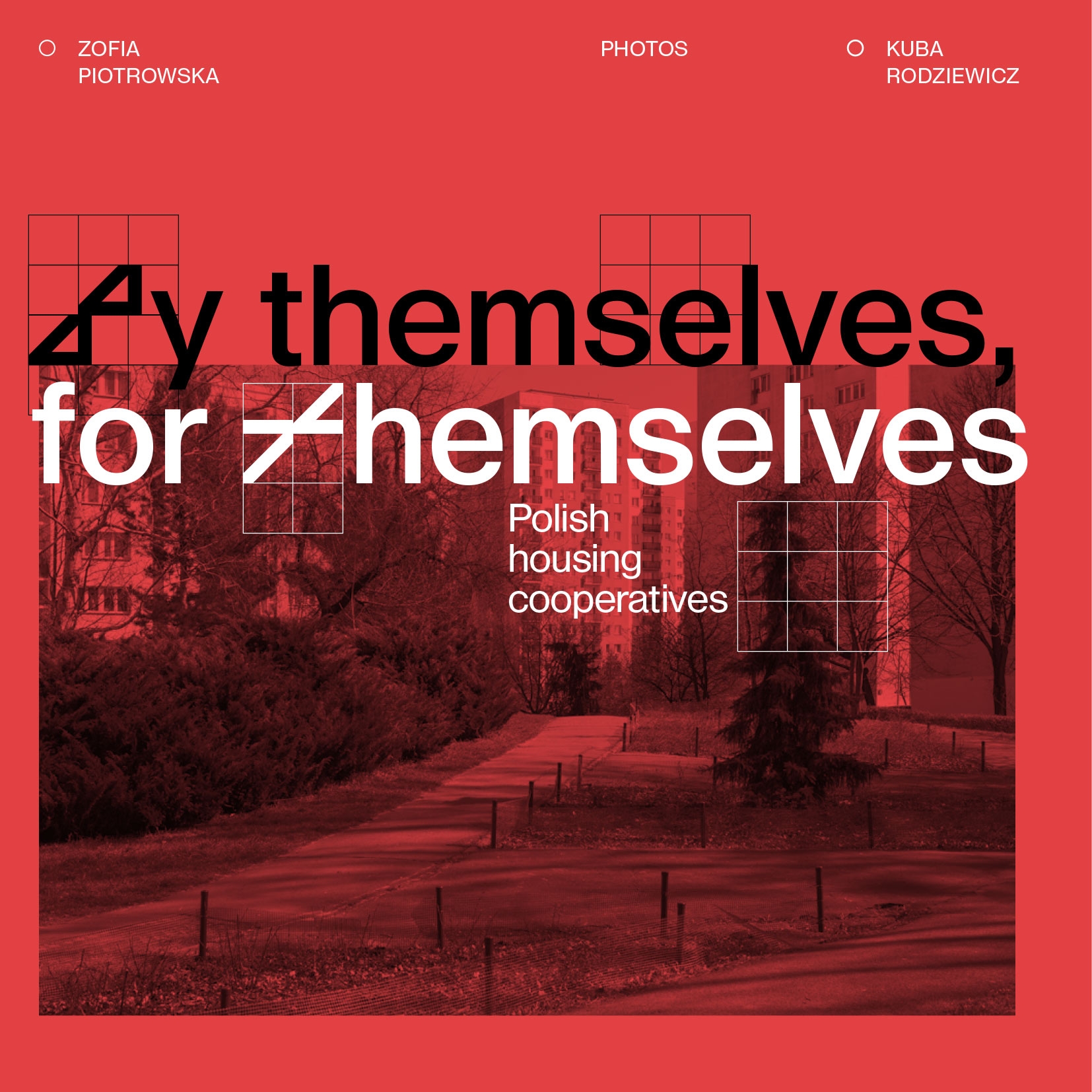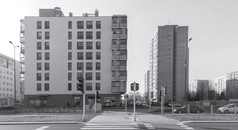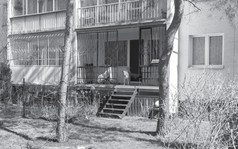Polish housing cooperatives
Dreams of cooperation
Cooperative movement, one of the most interesting social ideas, is a system based on self-organization and commitment of all participants. It implements the concept of direct democracy not in the political dimension, but in the direct building of the economy. Cooperatives can be treated as an economic utopia built around the ideals of equality and self-governance, or as one of the methods of managing a company. Either way, we should not forget that they are primarily a social movement.
Cooperative movement began to emerge since the mid-eighteenth century in England, the most developed capitalist country at the time. The first consumer cooperatives collapsed quickly – it turned out that ideas alone, without good organization and political support, were not enough. The establishment of the Society of Equitable Pioneers in 1844, a consumer cooperative of weavers from Rochdale, is considered a breakthrough for the cooperative movement. The principles formulated at that time still form the foundation of the international cooperative movement, and are called the Rochdale principles. Six, seven, or sometimes eight legendary founding rules are listed. Polska Krajowa Rada Spółdzielcza [The Polish National Cooperative Council] included them in the following points:[1]:
1. The principle of voluntary and open membership;
2. The principle of democratic member control;
3. The principle of member economic participation;
4. The principle of autonomy and independence;
5. The principle of education, training, and information;
6. The principle of cooperation;
7. The principle of concern for the local community.
Cooperatives developed the fastest in the area of food production and distribution. By the end of the nineteenth century, cooperatives accounted for up to 15 per cent of retail turnover in some countries. A social utopia has been turned into an efficient – or at least feasible – economic model that encompassed agriculture, commerce, industry and, later, also housing.
Recently, the ideas of cooperatives are gaining more and more popularity, and some point towards them as an alternative to today’s form of capitalism; a solution that would lead to a fairer and more sustainable economic development. Housing cooperatives are part of this strategy. To illustrate the latter, the most frequently cited example is the city of Zurich, where cooperatives own as much as 38 per cent of the housing stock (although the average for the entire Switzerland is only 5 per cent); three-quarters of them are small organizations, managing about ninety flats each, although there are larger ones that take care of 5,000 flats.[2] Large institutions, in the segment of one thousand to five thousand apartments, dominate in Germany. There are a total of two thousand such cooperatives in Germany, and they comprise a total of 2.2 million flats, which is slightly more than 5 per cent of the country’s housing stock.[3] Many German cities support the development of small cooperatives as a city-forming instrument and a means to supplement the built environment of downtowns, or to activate communities in newly emerging districts. Berlin and Hamburg are best known for such activities.
Even against the background of the European leaders – Germany and Switzerland, Poland is a unique country. In our reports, we are breaking records in terms of cooperative construction, also in comparison to other post-socialist countries. As recently as in 2015, 16.2 per cent of the Polish housing stock belonged to cooperatives, while neighbours with a similar history of public support for cooperative building models retained much smaller stocks – in the Czech Republic it was 9.4 per cent, and in Hungary only 1 per cent.[4] An outside observer might find the situation enviable; the Polish reader sees in these statistics only an image of a useless cooperative swamp.
Dreams of a new housing co-operative movement, such as the implementation of individual examples of building groups that would act as “urban acupuncture”, will not come true until we deal with the cumbersome inheritance of the previous system. Urban planners and activists dodge the subject even in the sphere of language: when talking about cooperatives, they limit themselves to one segment of the issue and to one – in fact, the most exclusive – investment model. And yet millions of Poles still live in cooperative flats. Without judging whether the latter are the noble legacy of socialism, or the cursed legacy of a system based on corruption, we need to ask ourselves what to do with this: repair the system, or finally eliminate it?
Path to glory
Poles created housing cooperatives already before the First World War. In the 1890s, the cooperative movement was active in the part of Polish territory that had been annexed by Prussia: the first organizations started operating in Bydgoszcz, Poznań and Toruń. In the interwar period, the Warsaw Housing Cooperative was established, extremely progressive both socially and architecturally. Many buildings were constructed in the formula of building cooperatives created by the wealthy part of the society. And yet the cooperative model did not dominate the market of new apartments; it did not even gain a significant share in that market, despite the fact that already existing organizations survived World War II. By the end of the 1940s, they managed to complete the construction of the Koło II and Praga I estates in Warsaw, which had started before the war.
It soon turned out that the new authorities wanted to take control of all areas of the economy; therefore, any kind of social activities were placed on the list of suspects. The established Zakład Osiedli Robotniczych (National Unit of Workers’ Estates) had a monopoly on the construction and distribution of apartments, while the role of the cooperatives was limited to managing the pre-existing housing stock.
The 1950s brought the “Thaw”. Apart from state-owned flats, the needs of the population were now to be met also by individual and cooperative housing. The constitution of 1952 even stated that “for the sake of the good of the families, the Polish People’s Republic strives to improve the housing situation; with the participation of citizens, it develops and supports various forms of housing, especially cooperative housing, and cares for the rational management of housing resources.”[5] Three types of cooperatives were established: tenant cooperatives (their members had a non-transferable right to the apartments, which meant that they could not transfer it to another person), construction and housing cooperatives (they ensured a limited property, transferable and hereditary right), and cooperative associations for the construction of single-family houses (after the building’s completion, members obtained full ownership).
The “golden age” of housing co-operatives had begun. We owe it not so much to legislation as to public funding, which continued until the 1980s. The own contribution for tenants’ flats was 10 per cent, whereas for construction flats, it was 20 per cent. Low-interest state loans were granted for a period of sixty years, and subsidies were sufficient to cover up to 40 per cent of the construction costs. As a result, until the 1990s, the average family’s housing expenditure remained below 5 per cent of the household budget.
The distribution of finances made it possible to control the selection of program beneficiaries. A 40 per cent quota for manual workers was established, which made cooperative membership a mass phenomenon. With time, especially after the complete cessation of municipal construction in the mid-1970s, some (possibly as many as half) of all completed flats did not go to those on the official waiting list; instead, they were distributed at the discretion of local authorities to administrative staff and service employees of large state-owned enterprises. The number of cooperative members who needed an apartment consistently exceeded the number of the lucky ones who actually got one. According to statistics from 1984, one-third of the applicants had been on the waiting lists for more than ten years, and it was common practice to open a housing savings passbook for a new-born baby.[6]
Central budget management made it possible to impose architectural and urban solutions – there were standards and construction systems using the prefabricated panel technology. An unquestionable advantage was the integrated planning of housing estates with social infrastructure, and the collaboration of public institutions with housing cooperatives. On the other hand, this also made it possible for buildings to be erected on land with an unregulated ownership status, which continues to generate many problems today.
Needless to say, such use of public finances inevitably led to an economic recession in the long run. In the 1980s, funds for the construction of apartments were significantly reduced, although only one important new provision was introduced in the legislation – namely, it became possible to establish land and mortgage registers for limited property rights (i.e. for cooperative ownership apartments), which could be mortgaged from then on. Without public funding, the cooperatives stopped building new homes. In the 1990s, a sharp decline in the number of newly built flats began, regardless of the type of the investor. In 1992, the last year before the collapse, the cooperatives still managed to build eighty thousand flats (63 per cent of all new construction); today they build only three thousand flats per year.[7]
The constitution of 1997 incorporates a policy that favours satisfying the housing needs of citizens, in particular counteracting homelessness, supporting the development of social housing and activities of citizens aimed at obtaining their own apartment.[8] The Act of 2000[9] implements this policy through the right to purchase tenant flats and legally separate them into isolated properties. Cooperatives can conduct real estate development activities and the profit made on those activities can be invested towards the renovation and maintenance of the existing housing stock.
A public image of cooperative movement
Despite the changes introduced at the turn of the twentieth and twenty-first centuries, which were unfavourable and inconsistent with the ideas of social cooperation and joint ownership, housing cooperatives are not seen to be the victims of the system. They are still perceived as privileged institutions that have found a comfortable corner in the current legal reality. Social perceptions are well illustrated by the report by Onet journalists Marcin Wyrwał and Mateusz Baczyński, published earlier this year, with a title that is stigmatizing the entire cooperative housing stock – simply “Spółdzielnia” [The Cooperative].[10] A journalistic investigation revealed irregularities in the functioning of the LWSM “Morena”, the largest housing cooperative in Gdańsk (it manages seventy hectares of land and has 6,500 apartments, inhabited by twenty thousand people).
On the tape recordings used in the material, we can hear the cooperative’s vice-chairman giving orders to damage staircases and cover walls with graffiti in order to extort money from insurers (“you have to write: ‘Kaczor oszust’, so that there is a political connotation”).[11] We also find that he forged the powers of attorney needed to vote and pass important decisions at general meetings, and he commissioned expensive legal services from pally law firms. Despite reports submitted for years to the prosecutor’s office and the Central Anticorruption Bureau, it was only at the beginning of February this year that the cooperative’s vice-chairman was read the charges. The interventions of Kacper Płażyński, MP of the PiS party and the publicity as the result of the journalists’ investigation certainly contributed to this.
The journalists’ report fits in with the common perception of cooperatives as habitats of pathologies or dysfunctions, fully subordinate to the CEO, in which passive members are deprived of any real influence on the functioning of the organization. The environment is dominated by older or middle-aged men, and that additionally reinforces the stereotype about the cooperative’s links with the previous system. In an interesting and otherwise important conversation, organized by the “Administrator” monthly, not only the invited CEOs of housing cooperatives, but also the journalist who interviews them, use language that disagrees with the spirit of democracy and equality. They comment on the activities of the cooperatives in the first or second person singular: “What will I do?”, “Will you sell?”, “Are you going to build?”, “I don’t know yet; for now, I want to buy land”.[12]
In fact, many cooperatives contradict this image: they carry out revitalization activities, improve the quality of common spaces, and take care of the cultural and social program. Some of them still build new apartments for their members, or use preferential loans to construct affordable rental housing. However, systemic problems are difficult to overcome, and the topic of housing co-operatives is stuck somewhere between an attempt to fully transform them into condominiums (i.e. unions of independent owners), and sluggish and relatively fresh concepts for using the existing organizations to provide affordable housing. The issue concerns almost five million Poles living in two million flats, so it is by no means marginal. Currently, cooperative housing is certainly far from being a social movement or an equality model responding to the pressing problem of the housing crisis. Does it have a chance to become that? Could it actually fulfil the ideas defined by the seven founding principles of cooperative movement?
Resuscitation of cooperative spirit in cooperatives
The principle of voluntary and open membership
The stock of cooperative housing is gradually diminishing, so it is difficult to talk about openness to new members. Admittedly, there are first timid attempts to persuade cooperatives to invest. Cooperatives were conceived as one of the pillars for the implementation of the National Housing Program, but despite the availability of state loans, not much is going on in this area.
Building tenant-owned flats for the needs of cooperatives’ members is meaningless. “Today we will build them for the members of the cooperative […] and tomorrow a tenants’ association will institutionalize, and we will lose both the building and our members,”[13] accurately observes Grzegorz Jakubiec, CEO of the SM “Służew nad Dolinką” housing cooperative. The members are also reluctant for their neighbouring area to be filled with more houses, and are blocking their construction at general meetings according to the “not in my backyard” principle.
Despite the willingness of many people to “take matters in their own hands”, new cooperatives are not emerging either. There are, of course, exceptions: a handful of building cooperatives registered in several Polish cities.
Looking at developers’ margins, I am wondering whether it would make sense to establish my own housing cooperative aimed at building a block of flats for my own needs […] Do you know any websites, blogs, online forum threads describing the process of preparing such an investment venture in the organizational, legal and procedural aspect?
The cooperative law is so confusing that it is much better to establish a special purpose vehicle for that.[14]
Cooperative housing is a closed resource. Within this segment, only 2,700 new flats are built in cities each year – this accounts for as little as 2.2 per cent of all constructed apartments.[15]Besides, there is no way of knowing which part of the cooperatives’ output is sold on the market, and which part is allocated to the members’ own needs.
The principle of democratic member control
To some extent, the stereotypical view of cooperatives is confirmed: on the one hand, they are run by CEOs and supervisory boards who are “glued to their seats”, and on the other hand, members are not interested in the activities of the cooperative and do not participate in the management of the organization.
In one of Lublin’s housing cooperatives, only two out of seven hundred members (0.1 per cent of all those eligible) attended meetings of the council of real estate representatives in 2017–2019, the meetings of the supervisory board were attended in comparable numbers, whereas eighteen people (2–3 per cent) attended general meetings.[16] A similar, although less extreme, trend has been observed in the Szczecin study: members rated the work of the board as poor (22 per cent) and as average (40 per cent), but they never attended meetings (39 per cent) or only participated sporadically (42 per cent). As a rule, smaller cooperatives are characterized by a greater degree of their members’ involvement.[17]
There are voices proposing the introduction of the principle of rotation in office or limiting the term of the cooperative’s management board. At present, the board can only be recalled, which, as everyone knows, is much more difficult than voting it in for the next term. It would also be worth introducing direct election of CEOs – currently this is the competence of the supervisory board. The latter, in turn, should treat their work as a public service and should not be remunerated for it. Some of the changes are meant to be introduced soon.
The principle of member economic participation
On thematic social networks, people express the following opinions about the purchase of a cooperative flat:
Among the disadvantages of flats in the cooperative ownership model, there are also possibly (although this is not a rule) higher fees than in the case of tenant-owned flats. Higher fees result from the management structure of the cooperative. The majority of the existing cooperatives have a very extensive system of cooperative staff: CEOs (and their deputies), accountants, administration and technical employees. The remuneration of these people is collected precisely from the tenants’ fees.[18]
This, however, does not always have to be the case. Some cooperatives discourage their members from converting their apartments into a separate property – they are tempting them with lower rents; also, they often own real estate that brings additional profits (for example, shopping pavilions) or conduct real estate development activities that help reduce contributions to the renovation fund. A “diverse portfolio” not only helps to balance the finances; it is also of great urban value: commercial premises are rented rather than purchased – whereas most real estate developers have a problem with putting such spaces to business use, so they try not to include them in their designs.
The principle of autonomy and independence
After the experiences of the previous system, the foundation footing of the idea of autonomy and independence needs to be properly re-established. Investing in residential property constitute a safe and valuable business model. Cooperatives operate in the long-term perspective, and they need state support in the current system, which is focused on quick profit. However, this does not call for repeating unsustainable course of action such as the one that the authorities of the People’s Republic of Poland took. Instead, we should enable cooperatives to carry out their investment projects over a longer period of time – and in order to do that, we need guaranteed interest rates or loans, or spreading the repayment of land costs over time.
Autonomy is also associated with the possibility of efficient management, and the latter is linked with the size of the organization. In Switzerland, small cooperatives within one building are preferred, whereas the largest German organizations manage up to five thousand apartments. In Poland, a “medium” sized cooperative counts between two and five thousand members, whereas the Warszawska Spółdzielnia Mieszkaniowa (even after excluding Koło and Chomiczówka, once parts thereof) has as many as thirty one thousand members!
The structure of prefabricated housing estates is not conducive to the fragmentation of management. Alas, large-scale activities result in the lack of accountability for the quality of space, which is a grievous malady of Polish housing estates. Cooperatives could operate as an association of smaller units or under the supervision of umbrella organizations managing renovation funds and maintenance of common areas, but under the current legislation, the division of cooperatives into smaller entities is so complicated that it is virtually impossible to carry out in practice.
1970s, now forms part of MSM “Energetyka”
The principle of education, training, and information
Cooperative democracy is not easy, and it cannot be expected that the current members, who have acquired their membership by chance rather than by choice, will decide to actively participate in it. Without the transparent system and precise law, it is not reasonable to expect things to change.
The community of urban researchers seem to have written off the topic of housing cooperatives; the latter are not mentioned in the discussions on affordable housing. Instead, new investment entities are created: Social Housing Associations (Towarzystwa Budownictwa Społecznego), Social Housing Initiatives (Społeczne Inicjatywy Mieszkaniowe), newly founded cooperatives (work is underway on the definition of the latter as a legal entity). Considering the complexity of the cooperative law and fossilized organizational structures, the strategy of “starting anew” could lead to real changes faster, but it is also worth fighting for the existing cooperative housing stock, which comprises huge areas in city centres, with full infrastructure and regeneration potential – provided that these housing complexes will be “condensed” in a clever way.
The principle of cooperation
Over the years […] developers grew stronger, organized themselves into unions, created their own lobby, and meanwhile what have we done to survive on the market? If we don’t organize ourselves, if we do not formulate the concept, the model for our operation, then nobody will do it for us. We react to existing regulations and we adapt to them, but we do not try to create the regulations ourselves
– such is a bitter conclusion reached by Jacek Frydryszak, chairman of the board of the SBM “Dom” housing cooperative.[19]
While there is talk of CEOs blocking management-restructuring regulations, which affect them directly, the public debate mainly covers members fighting for full ownership and freedom from cooperative restrictions. The Housing Europe federation brings together entities involved in public and social housing, and one of them is the Związek Rewizyjny Spółdzielni Mieszkaniowych RP (The Auditing Union of Housing Cooperatives of the Republic of Poland). The “cooperative lobby” should encompass the existing organizations as well as the future cooperative movement, representing the interests of both members and management boards. Otherwise, it will continue to be perceived as a herd of CEO’s friends and relations.
The principle of concern for the local community
Housing cooperatives are still actively pursuing cultural and social functions – they run residents’ clubs and local community centres or collaborate with foundations that conduct this type of activity. This “old school” endeavour is a positive heritage of the People’s Republic of Poland, and should be preserved and supported.
Many housing cooperatives, especially those managing complexes of blocks of flats, also manage public green areas, which are used by both their own members and residents of other, newly erected buildings, even though the latter do not contribute financially to their maintenance. The real estate development activity of cooperatives, consisting in irreversible privatization of a part of the common resources, reinforces this phenomenon even further.
The social dimension of a cooperative may also manifest itself in an individual approach to its members, also in the dimension of settling receivables. Already at the moment, some cooperatives offer the possibility of replacing the flat with a smaller one with the financial compensation used to repay the debt. Flexible adaptation of flat sizes to the changing needs of owners within the same neighbourhood is a response to the problem of elderly people trapped in too large apartments, which are expensive to maintain.
Cooperatives’ greatest strength comes from their ability to create a holistic picture of the living environment – including infrastructure, community, green spaces, and cultural activities. Despite many barriers and irregularities in the Polish system, comprehensive management of the housing stock is a value cherished in many housing estates. Separation into individual properties would result in the loss of this asset.
New rules
The present ruling party, Prawo i Sprawiedliwość (Law and Justice, PiS), became interested in cooperatives (as well as in many previously forgotten matters related to housing). In 2017, the first law strengthening membership rights was adopted, and there are plans to introduce direct elections and rotation in office for management boards. The Ministry of Development, Labour and Technology also proposes new forms of co-financing for cooperative investments as part of a multi-faceted housing support program. Before we begin to praise the present government, however, let us wait for this concern to turn into reality. As the fate of the never-passed large re-privatization act has shown, PiS is better at diagnosing problems than implementing specific solutions.
“The latest idea of the Ministry of Development, Labour and Technology is a very fine diagnosis, predicting a half-hearted action. Still, any move towards restoring the idea of housing cooperatives in Poland deserves recognition,” lawyer and journalist Patryk Słowik believes.[20]
So far, the topic of two million cooperative flats has not emerged in the discussion on the availability of housing. The activists’ efforts are focused on developing the idea of building societies. And although the latter certainly constitute a valuable city-forming tool, they will always remain but a small-scale activity, dedicated to people in a comfortable financial situation.
The Mikrospółdzielnia (Micro Cooperative), launched ten years ago by Maciej Czeredys and Piotr Topiński, was an attempt to implement a slightly different vision. The originators wished to build a house whose residents would remain co-owners of the entire property with the right to lease individual units. This would ensure that the organization would continue as a social resource regardless of changing tenants. Several years’ work led to the creation of an organizational framework necessary for the implementation of the venture. Although the project was guided by the idea of cooperation, its proponents decided not to incorporate under the cooperative law. The limited liability company model was chosen – because it is an uncomplicated legal form, and it does not require tons of documentation and by-laws. The biggest obstacles to obtaining commercial credit were the company’s lack of experience in conducting similar investment projects, and the tenants, who would become a problem in the event of the bank taking over the building. Ultimately, a financing model was developed not in the form of a mortgage credit but a leasing contract; the building would remain the property of the bank until the loan is repaid.
The implementation of the project was thwarted by the city’s land-plot sale system. Warsaw city’s tender procedure requires the winner to deliver the cash quickly (although in practice the deadlines may be extended, it is difficult to base the success of an investment venture on an uncertain decision of officials); thus, it gives preference to capital groups, and discriminates against entities, which use sources of financing that require a longer time frame. In the end, all the plots indicated by the Mikrospółdzielnia in discussions with officials (including the plot at number 4 in Sprzeczna Street) were bought by commercial investors.
The city also pursues a policy of merging small plots into large construction areas, ultimately discrediting small entities, and destructive to healthy city-forming processes. We need to emphasize that the problems of the Mikrospółdzielnia did not arise from the city’s operation on a commercial basis, either in terms of credit-granting or the price of the plot (small and large plots are sold at the same price per square meter). Giving social initiatives enough time to obtain the funds and complete the formalities would be enough to support them.
“For me, the biggest shock was that the bank understood us better than the municipal officials did,” Piotr Topiński told me.
We should not expect public aid such as dedicated tenders or preferential loans (although such instruments already exist). Let us work to ensure that all investment entities have equal opportunities in the housing market. The main principle of the cooperative movement (which one of the cooperatives from Świecie adopted as their proper) – “Help thyself” – is currently impossible to apply.















